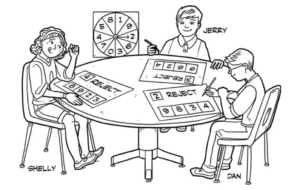Math Lab Activity
– Reject a Digit Game
Objective:
Students will engage in logical thinking as they discuss place value as it relates to computations involving addition, subtraction, multiplication, and division.
Materials Needed:
- Enlarged spinner with numbers 0 through 9
- Paper clip
- Pencil
- Paper plate (optional, for stability)
- Individual record-keeping pages or photocopies of a record sheet
Instructions:
Prepare the Spinner:
– You can cut out the enlarged spinner and glue it to a paper plate for stability.
– Lay the paper clip on its side, with one end overlapping the center point of the spinner.
– Insert a pencil through the end loop of the paper clip, ensuring that the pencil’s point is at the center of the circle.
– With one hand, flip the paper clip to make it spin. The paper clip will randomly point to different numbers on the spinner.
Create Record-Keeping Pages:
– Print a record sheet. You can draw digit boxes and a reject box on this page. An example of digit boxes and a reject box is provided.
Play the Game:
– Decide whether you want to aim for the largest or smallest numeral.
– The goal is to create a multi-digit number using the numbers generated by spinning the spinner.
– Follow these rules:
- Every time the spinner stops, write the number that comes up in a digit box or in the reject box on your record-keeping page.
- You can write only one numeral in the reject box.
- Once a numeral is written, it cannot be moved to a different box.
- Spin the spinner one more time than the total number of digit boxes on your record-keeping page. This extra spin is for the rejection.
Game Variations:
– Once you’re familiar with the basic rules, you can play “Reject a Digit” in different computation situations. For example, you can aim to create the largest/smallest number with specific place values (e.g., the largest number with the most 5s).
– Experiment with different strategies and choices.
Example:
In the game of ‘‘Reject a Digit’’ shown below, the students had each been trying to get the largest numeral. The spinner stopped in succession on 8, 4, 9, 3, and 2. Dan won, of course, but the discussion to follow is likely more important; concern might be what numbers were achieved, why a number was put in a certain place value location or was rejected, and so on.

Ignite Your Mathematical Mind:
- Do the activity using addition, subtraction, multiplication, or division. In each of the situations below, it is necessary to spin for six numerals; five are to be placed in digit boxes, and one is to be rejected. Before starting, whether you are looking for the largest or smallest solution, or even the solution closest to a target number. As you proceed, entering numbers in boxes, you should keep in mind whether you are trying to get the largest or smallest sum, difference, product, or quotient.

- Spin for a selected number of digits (perhaps four) and challenge the players to use them to devise all possible problems of a certain type, such as addition.
For example, if the numbers happen to be 1, 2, 3, and 4, some possible arrangements might include 1 + 2 + 3 + 4 = , 12 + 34 = , 31 + 42 = , 43 + 21 = , 1 + 23 + 4 = , and 123 + 4 = .
- Calculators may prove helpful, especially for problems with large numbers of digits. Also, when players are able, consider problems with more than eight digits (most calculators have only an eight-digit display).
- Explore how changes in rules might affect the results.
Have fun playing and learning with the “Reject a Digit” game!